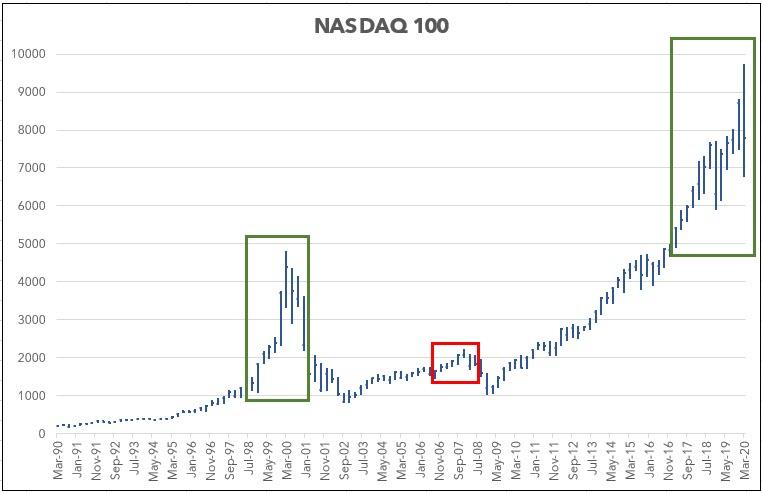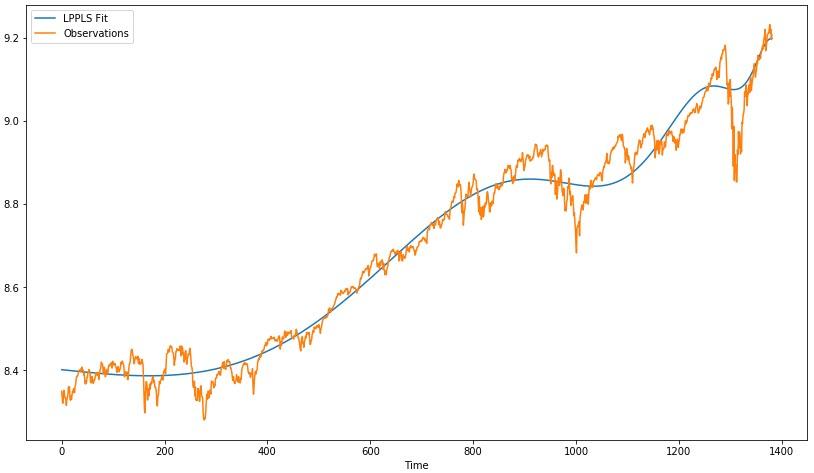It Is All About Waves: Tech Stocks & The Log-Periodicity Power Law Singularity Model
Tyler Durden
Wed, 07/01/2020 – 17:45
Authored by ‘Romain’ via The Swarm blog,
Many people claim that economics is not a science. Some of them say that because predictions often fail on the long run, while others think that a human science should not be treated like “rigorous disciplines” such as physics or chemistry.
However, that postulate is misleading. There are too many intriguing similarities between economic activity and natural phenomena such as seismic activity, species evolution, or epidemics.
According to Danish physicist Per Bak, science can be divided into two distinct categories:
“Hard sciences, in which repeatable events can be predicted from a mathematical formalism expressing the laws of nature, and soft sciences, in which, because of their inherent variability, only a narrative account of distinguishable events post mortem is possible.”
From that perspective, economics and finance can be treated as soft sciences.
It is true that predictive models are likely to fail, but mainly because of nonlinearity and unboundedness issues. Economics is a science, but most people apply wrong methodologies.
Criticality and Market Crashes
Bak wrote a brilliant book called How Nature Works, explaining that economic crises or capital market crashes are similar to earthquakes, solar flares, or floods, and empirical surveys show that volatility spikes are effectively distributed like earthquakes magnitudes (i.e. the Gutenberg-Richter law). If there are common patterns to markets and other natural phenomena, then it might be possible to formulate a general theory of complex systems that will help us to understand their dynamics. That intuition led to the concept of self-organized criticality.
While Per Bak passed away in 2002, other physicists have explored this new exciting field called “econophyiscs” and have produced complex but interesting models describing asset prices dynamics. The most famous one is the so-called Log-Periodicity Power Law Singularity (LPPLS) model, as detailed by French professor Didier Sornette in Why Stock Market Crash: Critical Events in Complex Financial Systems.
Despite its intimidating name, the LPPLS model is an ambitious attempt to detect the formation of speculative bubbles and predict a future market crash. Indeed, Sornette and other researchers believe that significant booms and busts exhibit typical patterns, such as an acceleration of fluctuations before the crash. Thus, it might be possible to properly anticipate them.
It may sound crazy and some authors have already questioned the validity of the LPPLS model. However, we live in a time of madness and fundamentals do not seem to matter anymore (again), so it might be worth applying the LPPLS model to Nasdaq 100 index just out of curiosity.
Nasdaq and the Roller Coaster
We can start with a simple look at the NDX index chart which enables to visualize an acceleration of prices fluctuations from 2018 to 2020, a pattern that looks similar to the 1998-2000 period.
One could argue that such a pattern was not visible from 2006 to 2008. But this is exactly what it is all about. The 2008 bear market was triggered by an exogenous event, a mortgage crisis that turned into a severe credit crunch, while the 2000-2002 correction had pure endogenous causes, and so had the 1929 and the 1987 crashes.
Isn’t the Covid-19 pandemic an exogenous event too? Yes, but it has not led to a real bear market anyway, so there might be something bigger going on. Moreover, people like Nassim Nicholas Taleb have spent the past weeks claiming that coronavirus pandemic should not necessarily be regarded as a black swan.
In fact, if you look carefully, you will easily notice that the market has been more and more overwhelmed by the intersubjective “Fed put” narrative, and it has become so important that if has offset fears related to a trade war, a recession, a virus, or anything else. We could even call it “a new paradigm”.
While the market tends to display a macro-behavior, price fluctuations have accelerated since 2018 because the fight between bulls and bears has become more and more intense, a fiercer competition between the dominant narrative and the anti-narrative, a faster swing from positive feedback loops to negative feedback loops.
The Verdict
Thus, the question is, are we on the verge of collapse? Does the LPPLS model confirm such an intuition?
Folks from Boulder Investment Technologies blog developed a Python library which enables to run a straight-forward version of the model. The LPPLS model is an optimization problem with seven parameters, including the critical time (i.e. the date of termination of the bubble and transition in a new regime). In other words, if we find parameters that enable to generate predictions that fit well with real data, then we may have the confirmation that a bubble has formed and we might be able to determine when it is likely to end.
Of course, this is purely theoretical. Nevertheless, it is worth noting that the LPPLS model fits pretty well with NDX data from 2015 to 2020 (see chart below). Why do we start in 2015? Because there has been a significant upward acceleration of tech stocks since that date.
Then comes the question of the critical time.
Once again, this is purely theoretical, but the model suggests that the bubble terminates by the end of the summer.
This should not come as a surprise given US political agenda and C-19 threat.
Narratives, Beliefs and Crises
Finally, it is all about the survival of the dominant narrative, and the idea that securities cannot drop just because there is another participant (i.e. the central bank) buying them. Unfortunately, history shows us that such interventions never succeeded into preventing a crash, so everyone should bear in mind that the “Fed put” is mainly an intersubjective postulate without any scientific foundation.
Somehow, if people start to think differently, then what will support the market? Especially given concentration risks and short-volatility bets (see my former posts To Be Passive Is to Let Others Decide for You and Stranger Things).
Sornette might be wrong and the LPPLS might fail. However, if it turns out that the model is right, then you’d better brace yourself for one of the biggest volatility spikes of your life.
via ZeroHedge News https://ift.tt/2NOi13K Tyler Durden

